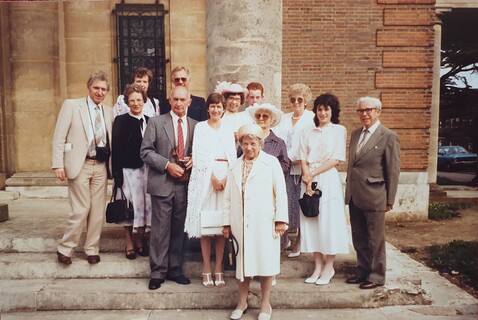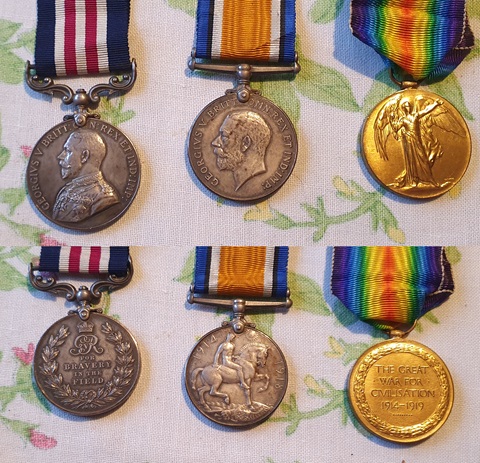
Back to: SingSurf home page Derek Morris
Parkers have lived in West Ham since at least 1654 when Roger Parker was married at All Saints Church.
Between 1700 and 1800 over twenty families named Parker lived in West Ham and while some of these were related others would have been newcomers attracted to West Ham with its growing industries, the shipyards by the Thames and by the rural nature of the surrounding fields and orchards.
The first mention of a Richard Parker occurred in October 1754 when he was married to Mary Jennings by Hugh Wyat, the Vicar of All Saints, West Ham. Neither Richard or Mary could write so they both made their crosses ses on the marriage certificate in front of the witnesses J. Watkins and Edward Butch.
It seems probable that they also named their son Richard and he married a girl named Lydia.
Their son Richard Parker was christened at All Saints, West Ham on the 12 June 1796 and from him we are descended. Other names that can be traced back to 1760 in West Ham include Burrows, Sparks, Chalkley; three families that were laterito marry into the Parker and Morris families
That West Ham residents had overseas connections is shown by the baptism in 1798 of Jane Caroline Dick who had been born in Bombay in 1791. Probably her father worked for the mighty East India Company
Derek Morris, June 2000
Richard Parker spent all his life as a Sawyer (someone who saws wood, particularly using a pitsaw) in West Ham and Plaistow until he died in 1843.
About 1822 he married Susanna Sarah Haley and like many other Victorian families they had a large family, which eventually included :-
With a large family and her husband only earning a labourer’s wage Susanna became a launderess and probably took washing into their home. In those days there were only small charity schools so probably their children would have been playing around the house and in the street or perhaps running to neighbours to collect and deliver bundles of washing. Although there was no state education we know that someone taught the children to write at least a few words, for Richard was able to sign his Wedding Certificate.
By 1841 they were living at 35 Balaam Street near the Greengate in the East End of London and this was also their home in 1851.
However, by then tragedy had hit the family. The youngest daughter, Sarah, died in 1842 when only two years old and within a couple of months the father, Richard Parker, had died at the age of 47. Within a few months both Henry and Esher were to die, while still young.
Thus Susanna Parker was left a widow with four children to support, which she did for the next twenty years until she died in 1863 at the age of 63. She was still taking in laundry in 1851 but now the two oldest boys, Richard and William were working. With little education their choice of jobs was limited and they were both working as labourers. With Victorian England enjoying boom conditions, with ships trading all over the world, there was plenty of work in and round the East India Docks which had been established nearly fifty years earlier. But were any of the boys encouraged to go to sea ?
A few years later William Parker started courting Marie Croucher, who was living in Bow and they were married on 10 May 1857 at St. Mary’s Church, Stratford. Marie could not write so had to make a cross on the Wedding Certificate; a very common feature until the 1870s when compulsory education was introduced.
Following his father’s example William Parker also decided to have a large family, which included another Richard Parker, from whom we are all descended. Many of his brothers and sisters are still remembered in the family :-
Bill, who worked as a roadsweeper and was married to Sarah ( or Rebecca ?). They lived in Canning Town and had an adopted daughter Laura, who died when young in 1914.
Aunt Liz, was a spinster who lived in Silvertown and died in February 1941. She was a “kindly soul “ and worked at Keiller’s Factory. She used to buy a quarter of a pound of sweets for 2d to give to her nieces when they visited her.
On the night of the great Silvertown Explosion in 1917, she went to stay with Richard and Laura Parker at 33 Desford Road in East Ham.
Harry married Magsy and they had a deaf and dumb son, who worked as a shoemaker.
A sister Ellen or Helen died when young.
Uncle Arthur married Aunt Tiny, who later committed suicide. Uncle Arthur went to live with Laura in 19?? and died in 1948. I remembered him for his bushy moustache.
The youngest brother was George, who was a ships engineer and married Violet.
Richard Parker was born on 29 March 1873, when the family were living at 34 Webb Street, Plaistow. He married Laura Jane Reed from Kirby le Soken in Essex on 27 August 1896. They went to live at 33 Desford Road, which was then surrounded by fields, which stretched across to Stratford. For many years Richard Parker worked at Wickens and Rill, ship chandlers in the Tidal Basin. He was made redundant during the years of the depression, never worked again and died soon after in January 1927 or 1928.
The Reed family can be traced in the Kirby le Soken area back to the 1650s.
We still have to discover where the Parker and Croucher families came from.
The Morris family can be traced back to about 1740, when a Richard Morris, cordwainer (shoemaker) lived in Mile End Old Town, Stepney.

Henry Lawrence Parker was killed on the 26 October 1918 only 16 days the Armistice. He was 20 years old.
Laurie had been conscripted in 1915 and had joined the Essex Cadets in thier camp at Gidia Park. After camps on Norfolk and Aldershot he went to the front early in 1916.

The British Military Medal for Bravery in the Field.
British War Medal, a silver medal was awarded to officers and men of the British and Imperial Forces who either entered a theatre of war (an area of active fighting) or served overseas (perhaps as a garrison soldier) between 5 August 1914 and 11 November 1918 inclusive.
The Allied Victory Medal (1914-1919): The colours represent the combined colours of the Allied nations, with the rainbow additionally representing the calm after the storm. Awarded to individual had to have entered a theatre of war. 5.7 million Victory Medals were issued.
Back to: SingSurf home page Derek Morris